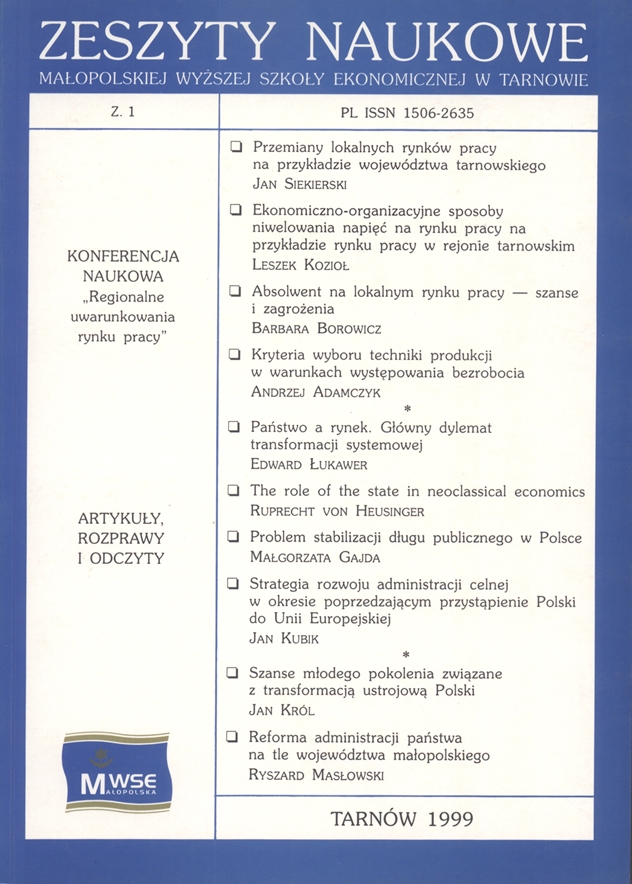Abstract
The argument of this paper is that this procedure is unacceptable. It first sets out to look at the expression "neoclassical" in general, dividing it into "old" and "new" microeconomics. Secondly, the (potential) role of the state is discussed in these microeconomic areas. The conclusion with regard to old microeconomics is along the lines of J. Stiglitz, i.e. the end of communism should be taken as a refutation of neoclassical economics. While the conclusion for new microeconomics hinges on the fatal methodological fault that one is capable of modeling everything.
References
Akerlof G.A. (1970), The Market for Lemons, “Quarterly Journal of Economics”, no. 34, pp. 488—500.
View in Google Scholar
Arrow K.J. (1987), Economic Theory and the Hypothesis of Rationality, vol. 2, pp. 69—74 [in:] Eatwell J., Milgate M. and Newman P. (1987), The New Palgrave — A Dictionary of Economics, London: Macmillan.
View in Google Scholar
Blaug M. (1992), The Methodology of Economics, 2nd ed., Cambridge: CUP.
View in Google Scholar
Blaug M. (1997), Economic Theory in Retrospect, 5th ed., Cam bridge: CUP.
View in Google Scholar
Brown C.V. and Jackson P.M. (1990), Public Sector Economics, 4th ed., Oxford: Basil Blackwell.
View in Google Scholar
Campus A. (1987), Marginalist Economics, vol. 3, pp. 320—322 [in:] Eatwell J., Milgate M. and Newman P. (1987), The New Palgrave — A Dictionary of Economics, London: Macmillan.
View in Google Scholar
Fisher S. (1989), Games Economists Play, “Rand Journal of Economics”, vol. 20, p. 113.
View in Google Scholar
Goldfarb R. S. (1995), The Economist-as-audience Needs a Methodology of Plausible Inference, “Journal of Economic Methodology”, 2:2, pp. 201—222.
View in Google Scholar
Heusinger R. von (1995), What is Left of New Classical Macroeconomics?, “Wincott Discussion Papers” 5/95, The University of Buckingham.
View in Google Scholar
Heusinger R. von (1997), The Structure of New Keynesian Economics, “Wincott Discussion Papers”, 2/97, The University of Buckingham.
View in Google Scholar
Heusinger R. von (forth coming), Methodological Criteria for Comparative Theoretical Economics, „Zeszyty Naukowe Małopolskiej Wyższej Szkoły Ekonomicznej w Tarnowie”.
View in Google Scholar
Lange O. (1949), The Practice of Economic Planning and The Optimum Allocation of Resources, “Econometrica” 17, Supplement.
View in Google Scholar
Little I.M.D. (1957), A Critique of Welfare Economics, second edition, Oxford: Clarendon Press.
View in Google Scholar
Murrell P. (1983), Did the Theory of Market Socialism Answer the Challenge of Ludwig von Mises? A Reinterpretation of the Socialist Controversy, “History of Political Economy”, 15:1, pp. 92—105.
View in Google Scholar
Peltzman S. (1991), The Handbook of Industrial Organization: A Review Article, “Journal of Political Economy”, vol. 99, no. 1, pp. 201—217.
View in Google Scholar
Pribam K. (1992), Geschichte des ökonomischen Denkens, Zweiter Band, Frankfurt: Suhrkamp.
View in Google Scholar
Samuelson P. (1967), Economics, seventh edition, New York: McGraw-Hill.
View in Google Scholar
Spence M. (1973), Market Signaling, “Quarterly Journal of Economics”.
View in Google Scholar
Stiglitz J. (1986), Economics of the Public Sector, 2nd ed., New York: Norton.
View in Google Scholar
Stiglitz J. (1994), Whither Socialism?, Cambridge, MA: The MIT Press.
View in Google Scholar
Summers L. H. (1991), The Scientific Illusion in Empirical Macroeconomics, “Scandinavian Journal of Economics” 93 (2), pp. 129—148.
View in Google Scholar
Sutton J. (1990), Explaining Everything, Explaining Nothing, “European Economic Review”, vol. 34, p. 505.
View in Google Scholar
Vaughn K.I. (1980), Economic Calculation under Socialism: The Austrian Contribution, “Economic Inquiry”, vol. 18, October.
View in Google Scholar
© Copyright by Małopolska School of Economics in Tarnów. The articles are available under the Creative Commons Attribution NonCommercial-NoDerivatives 4.0 International License


